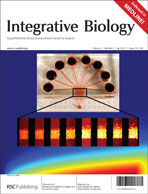P2Y12 or P2Y1inhibitors reduce platelet deposition in a microfluidic model of thrombosis while apyrase lacks efficacy under flow conditions†
Abstract
Determination of the patient-specific response to antiplatelet agents facilitates proper dosing for both acute and chronic prophylaxis. “Closed” systems (with or without flow) may fail to predict pharmacological potency in situations where


 Please wait while we load your content...
Please wait while we load your content...